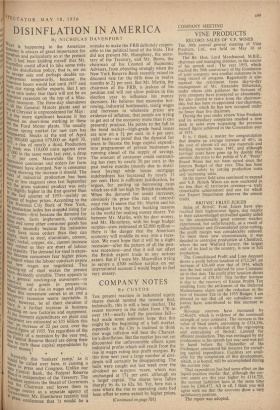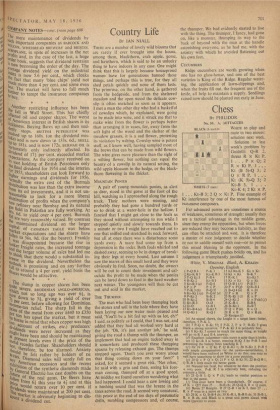COMPANY NOTES
By CUSTOS
THE present reaction in industrial equity shares should remind the investor that, technically, this is still a bear market. The recent recovery in the index from 170 to over 193—nearly half the previous fall— had made some optimists hope that this might be the beginning of a bull market. especially as the City is inclined to think that wage inflation will beat the Chancel- lor's disinflation. But the market has not yet discounted the unfavourable effects upon industrial profits which will result from the rise in wages eating into profit margins. By this time next year a large number of divi- dends will certainly be disappointing. The bulls were caught out last week over the dividend on WIGGINS TEAPE, Which was unchanged at 17+ per cent. although on a larger capital. The shares have fallen sharply by 4s. to 62s. 9d. Yet, here was a case where the rise in operating costs had been offset to some extent by higher prices.
(Continued on page 701)
SPECTATOR, MAY 18, 1956 COMPNyNOS—cont. from page 699 The mere maintenance of dividends by tleh important companies as BABCOCK AND WILC0X, WHITBREAD BREWERY and BRISTOL 440PLANE, in spite of increases in the net Prnfits and, in the case of the last, a huge 9rcler book, suggests that dividend restraint 14s„n0‘v becoming the order of the day. The 7'erage dividend yield on the industrial Index is now 5.6 per cent., which cloaks the fact that many 'blue chips' yield not linneh more than 4 per cent, and some even `cess• The market will have to fall much (arther to tempt the insurance 'companies to buy.
,L Another restricting influence has been
'fie fall in Wall Street. This has chiefly Ilfiected oil and copper shares. The worst °I,f American 'interest in British shares is its
dekleness. Buying flares up and then slid- enlY stops. BRITISH PETROLEUM was 1,L1,.'hed up to 160s. (on the dividend mis- 'tke) and is now down to 133s. 6d., SHELL it.IP 10 181s. and is now I72s. BURMAH on, is unately only indirectly affected. Its filvidend of 17+ pericent. exceeded market ,ttneetations. As the 'company received on
vast holding of British Petroleum only
(ne 6, nal dividend for 1954 and the interim 17' 1955, shareholders can look forward to 1\t,, gber earnings and dividends for 1956. (retuallY the extra cost of the Burmah ristribution was less than the extra income tram its oil investments, and it is not un- Psonable to look for a more liberal filstribution of profits when the company's refinery near Bombay and its natural gts field in Pakistbn are fully working. At 1 0.31 6d, to yield over 4 per cent. Burmah 1 are very reasonably valued. By contrast tie i Maintained dividend on the larger QaP of CANADIAN EAGLE was below It)arket expectations and the shares have Iallea to 56s. 9d. (for the bearer). Frankly (4,,A,:ag disappointed because the rise in ',"er freight rates, the increased tonnage l,„1,11e larger volume of sales had led me Jr mink that there would a substantial in- 10 the dividend. Nevertheless the eatluok •
fall Is promising and on any further to around a 4 per cent, yield basis the uares would be attractive.
Zile slump in copper shares has been wi,d10!1e severe. RHODESIAN ANGLO-AMERICAN, 40=1 not so long ago was over 6i, is 7,W dovvn to 51, giving a yield of over 4 Per cent, before allowing for Dominion preinthe-tax relief. The sharp fall in the Dereef. of the metal from over £440 to £350 be -b`" has upset the market, but it must orne in mind that when copper was high (livri;,,neeount of strikes, etc.) producers' Tends were never increased as they at gut have been and should be maintained 14efl,eserlt levels even if the price of the 40 *I recedes farther. Shareholders should sh t, therefore, be too alarmed. Anxiety lir°pbuld be felt rather by holders of DE tin's. Diamond sales will surely fall on ejl.,4Merican recession and the recent by Giuniml of the synthetic diamonds made futti-eneral Electric- has cast doubts on the Nene from the real gems. De Beers have Drie-" 1113M 6f this year to 4i and at this (livid!, Would return over 10 per cent. if The ends were maintained at 200 per cent. c0„ Market is obviously beginning to dis- "En a dividend cut.



































 Previous page
Previous page